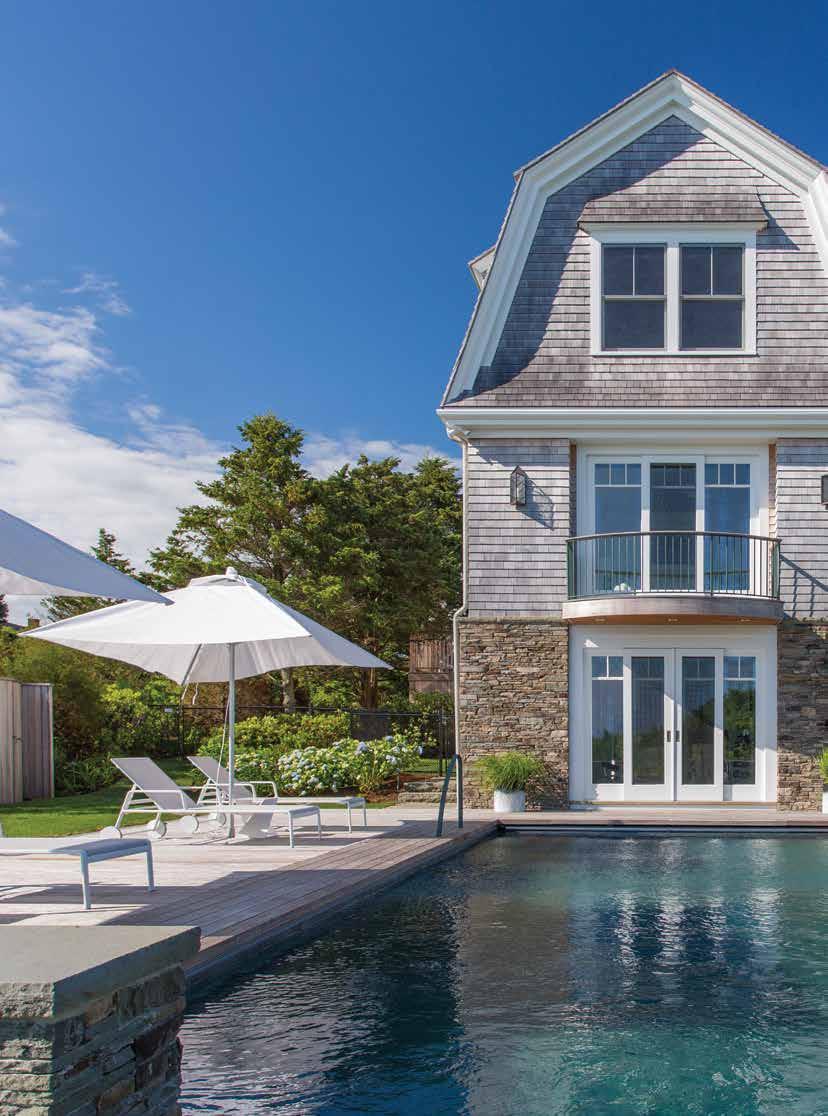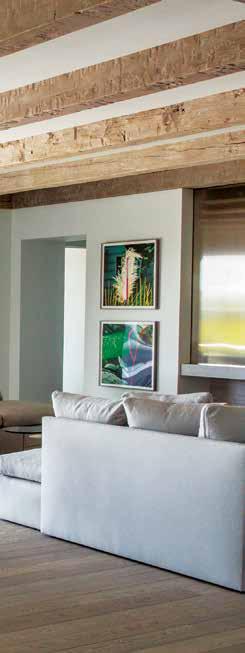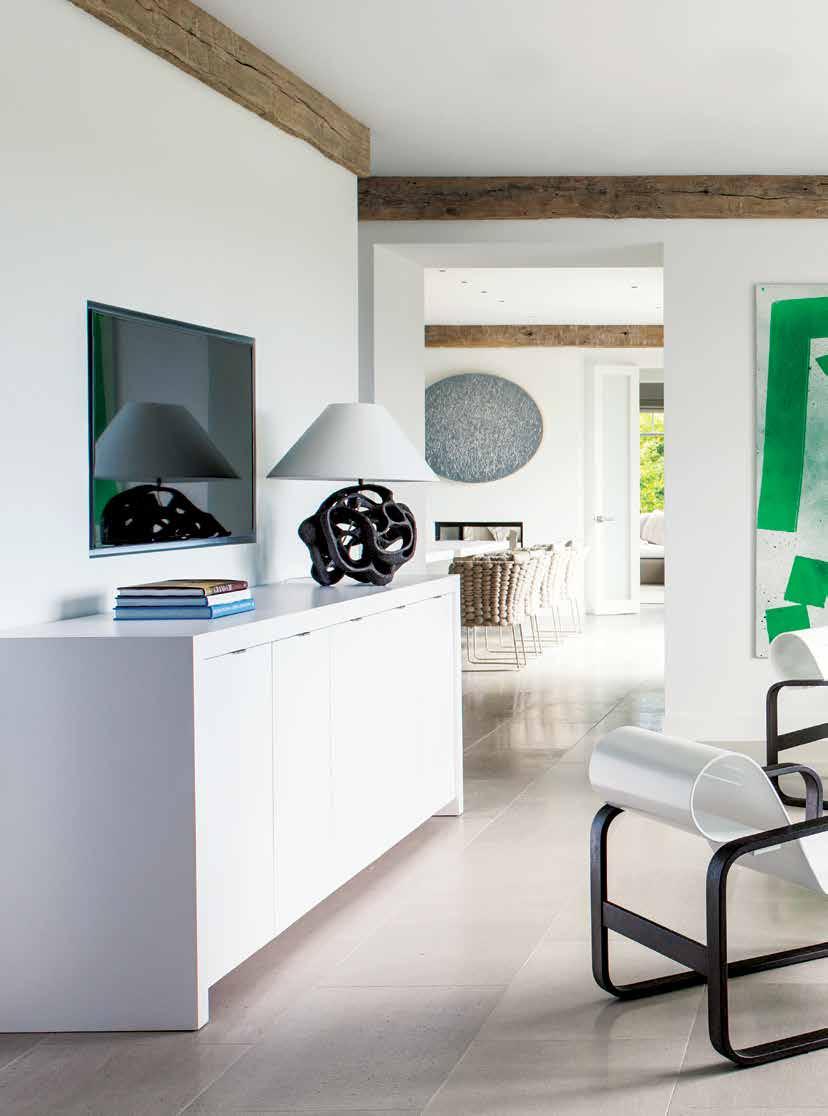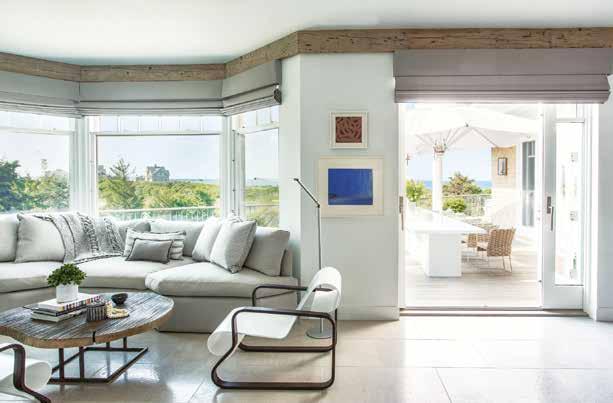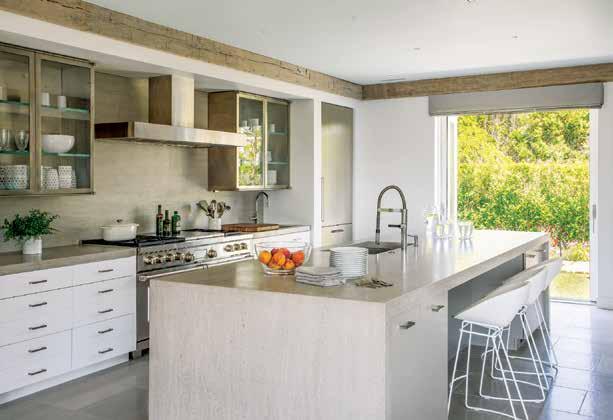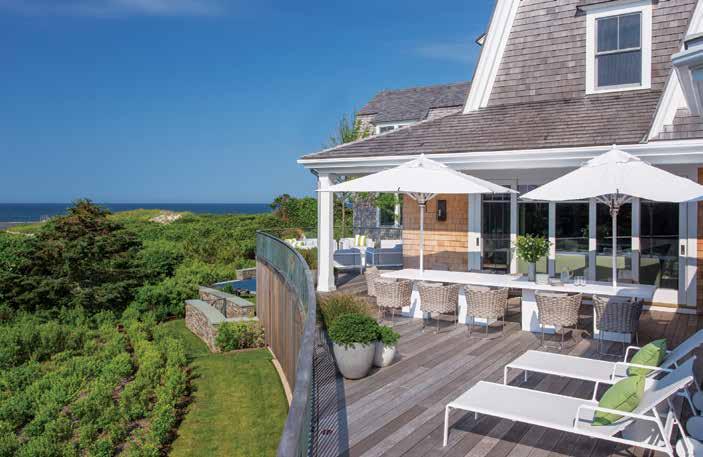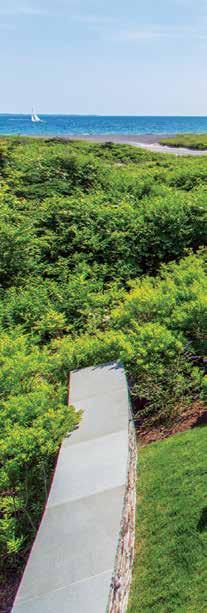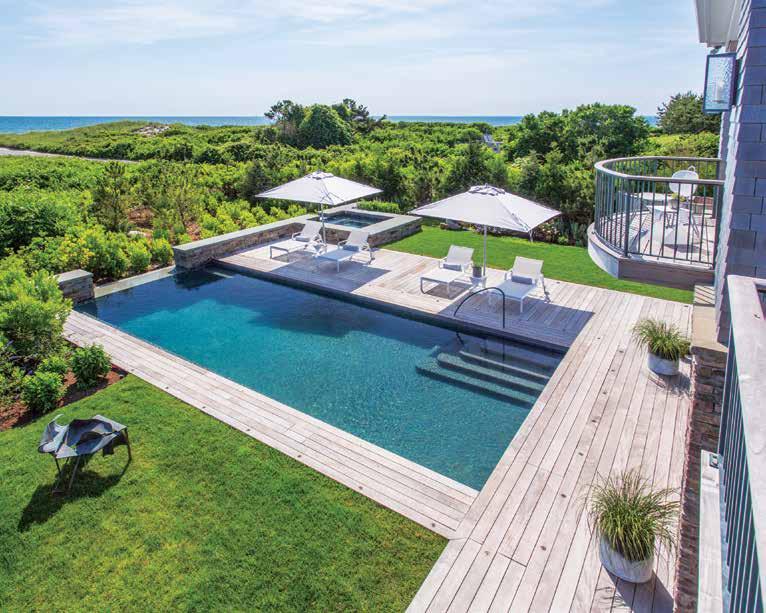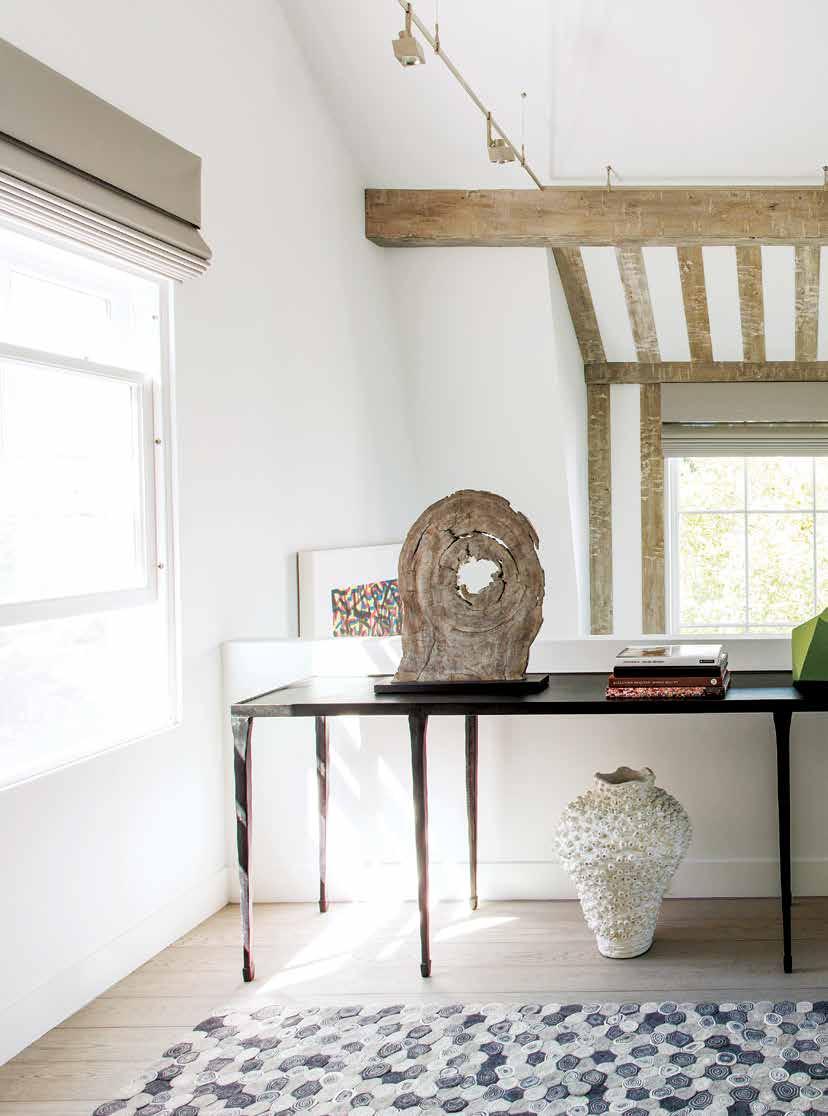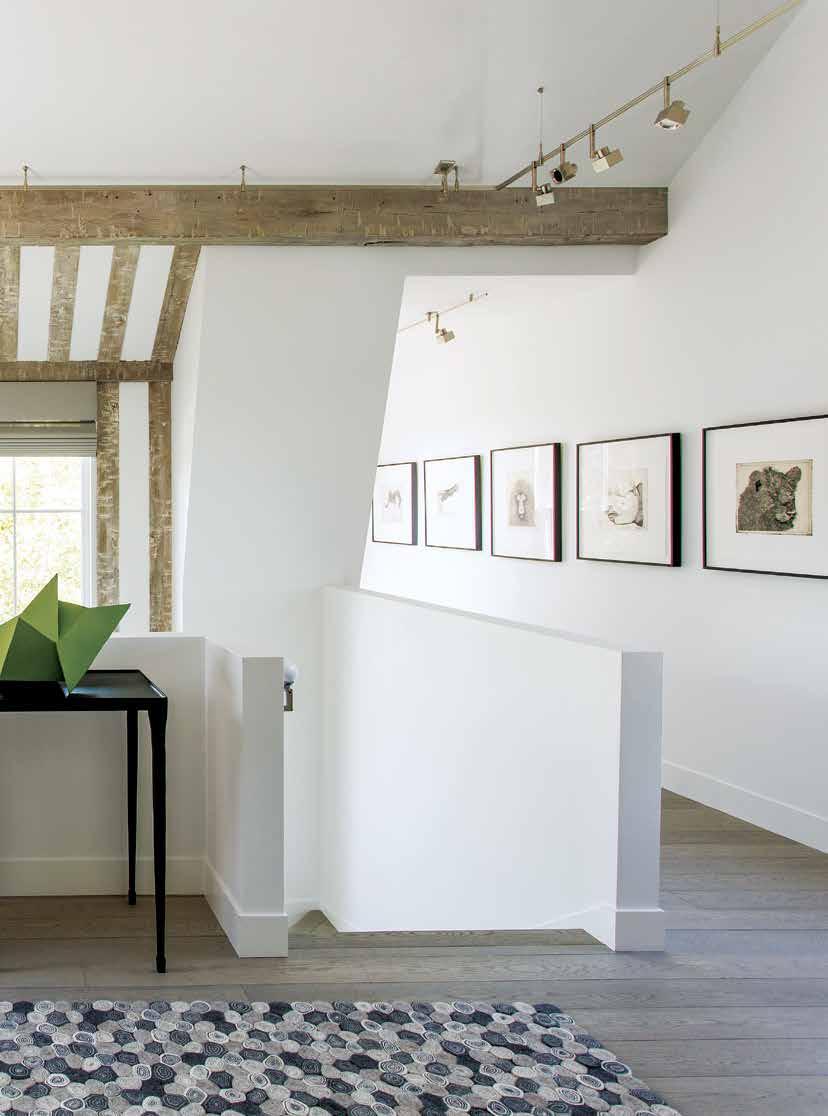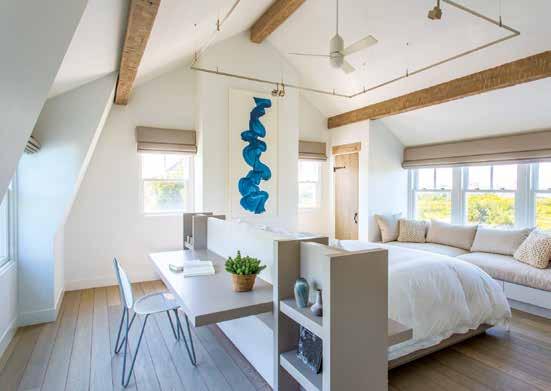Family Ties
Having enjoyed island summers since she was a girl, the owner of this new home relishes sharing her idyllic spot with the third (and someday, fourth) generations.
Text by Fred Albert | Photography by Eric Roth
Nearly fifty years ago, a Boston businessman and his daughter were boating around Buzzards Bay when they happened upon a private island. Ignoring the NO tresspassi N g signs, the pair stepped onto the beach and surveyed their surroundings.
“This is where I want our family to have a summer home,” declared the father. Knocking on a nearby door, he told the occupants that if they ever decided to sell, he’d be interested in purchasing their property. Sure enough, the family was considering a change, and the girl soon found herself basking in the briny
Cape Cod breezes, bicycling past sun-burnished cottages, and scouring the beach in search of heartshaped rocks.
Now grown with two adult children, she recently built her own home on the island—right next door to the one she summered in growing up. Designed
P RO j ECT T EAM
Architecture: Mark Hutker, Jim Cappuccino, and Kevin Schreur, Hutker Architects
Interior design: Richard Hallberg, Richard Hallberg Interior Design
Builder: C.H. Newton Builders
Landscape design: Kris Horiuchi, Horiuchi Solien
CLOCKWISE FROM FAR LEFT:
A game table anchors the center of the great room, whose retractable doors encourage easy indoor/outdoor flow, while sectional sofas surround a TV concealed behind stainless steel panels. The room’s other seating area is geared toward conversation and the view, with all-weather outdoor upholstery to withstand wet bathing suits and the owner’s Labrador retriever, Sam. The compact powder room off the dining room features a custom triangular sink crafted from limestone.
“ t he big question was: how do we create a house that is new, yet has the quality of the charming old New England beach houses?” recalls Richard Hallberg. “The only way we could really do that was to use antique timbers.”
CLOCKWISE FROM LEFT:
The limestone on the floor is repeated on the kitchen’s island and backsplash, where it contrasts with stainless steel cabinets. Antique hand-adzed timbers crown the walls throughout the main floor, instilling a sense of history and a rustic counterpoint to the sleek limestone floors. Designer Richard Hallberg used two tables in the dining room to accommodate large or small gatherings; the woven rope patio chairs can be used indoors or out.
by Hutker Architects, with interiors by Los Angeles designer Richard Hallberg, the shingle-style home rises out of the ragged dunes with stately Yankee dignity, its rambling roofline and weathered facade concealing a contemporary, open interior that’s as serene as a stroll on the beach.
“It really had to look like it had been there a hundred years, but function like a new home with modern efficiency,” says contractor David Newton of C.H. Newton Builders. To ensure that historic look, the architects accompanied their client on an excursion around the island, taking note of the elements she admired in other houses and incorporating many of those touches into their design.
Nearly all the sheathing was left unpainted, allowing the surfaces to weather naturally. The tapered columns with chamfered edges are common to the island, as are the cowl-like hoods crowning the windows. The latter not only protect the panes from rain, but produce shadows that animate the
architecture as the sun passes through the sky.
The six-bedroom, eight-bath home rests on a oneacre parcel bordering a salt marsh. “Even though the lot is larger, the wetlands took up a lot of that land, leaving a very small area within which to build,” says architect Mark A. Hutker. (The owner dubbed the undertaking “Project Shoehorn.”)
Roads on two sides of the lot also posed a privacy challenge, which landscape architect Kris Horiuchi addressed with thickets of evergreens, bayberry, and viburnum, along with a tidy hedge out front.
“I’d like a house that looked like it might have had additions put on,” the client told the architects, who responded by dividing the structure into three perpendicular wings containing private quarters, public spaces, and guest rooms. The approach helped diminish the scale of the house (since all three portions are rarely visible at once) and increased exposure to the light and views. “We wanted to make the house seem more modest when
CLOCKWISE FROM LEFT:
The homeowner says everyone congregates in the kitchen or on the deck, whose expansive table easily accommodates twelve. The deck railing follows the curve of the wetlands setback abutting the house; a second seating area at the rear capitalizes on its western exposure. The swimming pool culminates in an invisible edge that visually blends into Buzzards Bay.
you first encounter it,” says Hutker, who collaborated with project architect Jim Cappuccino and project designer Kevin Schreur.
At the client’s urging, the architects crowned the home with a gambrel roof, which tucks upstairs rooms under the eaves, resulting in a lower profile and the kind of angled, atticlike spaces the client remembered fondly from her childhood.
While the exterior hearkens back to the late nineteenth century, the interior is planted firmly in the present, with party-ready public spaces that flow into one another and deck doors that recede into the walls, allowing a seamless migration between interior and exterior.
At the same time, a sense of history pervades the space, owing mostly to the salvaged oak beams crowning the rooms and framing the staircase window. “The big question was: how do we create a house that is new, yet has the quality of the charming old New England beach houses?” recalls Hallberg. “The only way we could really do that was to use antique timbers.”
The sun-bleached beams are echoed in cerusedoak floors, which alternate with pale gray limestone throughout. “We wanted it to feel clean,” Hallberg says, “like the weathered colors of the ocean just washed in.” The materials palette is repeated throughout the house, lending a calming consistency to the space that’s enhanced by the white laminate furnishings and plump, bone-colored banquettes scattered here and there.
While the resulting look is sparer than your typical Cape Cod cottage, it felt absolutely right for a woman who collects abstract art from the 1970s to today. “You can’t put starfish tchotchkes with contemporary art and make it feel right,” she observes. “That doesn’t mean it doesn’t feel casual and beachy. But there’s nothing about it that’s cliché.”
Or high maintenance. Durable outdoor fabrics cover all the furniture, both inside and out. Hallberg even furnished the dining room with patio chairs, so they could be dragged out onto the deck when needed. “No need to worry about a damp bathing suit,” he says.
Artworks roost atop and below a Crate & Barrel table on the upstairs landing. The handcrafted felt rug from Patterson Flynn Martin reminded designer Richard Hallberg of cross-sectioned tree branches. The window on the stairway was framed with half-timbering, to make the house look like an old home that had been restored.
RIGHT: A desk doubles as a headboard in one of the guest rooms. The angled walls recall the attics the owner played in as a child. BELOW: A Wetstyle tub in the master bath overlooks scrub-covered dunes and the bay beyond.
FACING PAGE: A built-in banquette hugs the walls of the sunroom, which was designed to suggest a screened porch that had been enclosed.
“You can’t put starfish tchotchkes with contemporary art and make it feel right,” says the homeowner.
“That doesn’t mean it doesn’t feel casual and beachy. But there’s nothing about it that’s cliché.”
The sunroom on the east end of the house is wrapped with awning windows, conjuring thoughts of the Bahamas, which are underscored by the pyramidal wood ceiling overhead. But instead of a ceiling fan, there’s a pendant light that looks suspiciously like a life preserver—a sly nod to the home’s maritime setting.
The deck spans nearly the entire water side of the house, and is conveniently divided into eastern and western exposures for morning meals (atop a Brobdingnagian white table) or evening conversation (ensconced in generous upholstered seating). A radial railing skirting the edge follows the curve of the wetlands setback below, and culminates in a staircase leading down to the pool.
When guests aren’t gathered on the deck, they’re usually congregating in the kitchen—either sidling up to the limestone-covered island or kibitzing in the neighboring seating area. Stainless steel upper cabinets echo the finish on the appliances and the shimmering panels concealing the TV in the great room. A generous pantry keeps clutter securely out of sight.
The owner relishes the time she gets to spend at the house with her children, and looks forward to sharing the island with a fourth generation of the family someday. In the meantime, there’s no shortage of diversions to fill family weekends. “I still look for heart-shaped rocks on the beach,” she confesses, wistfully. “And now my daughter and son collect them, too.”
RESOURCES For more information about this home, see page 162.

